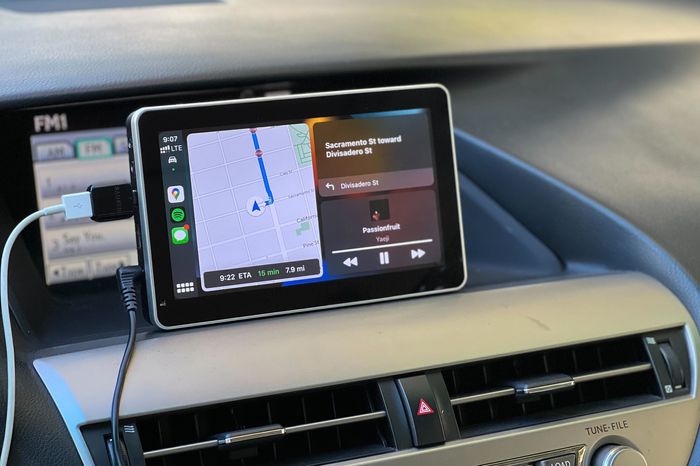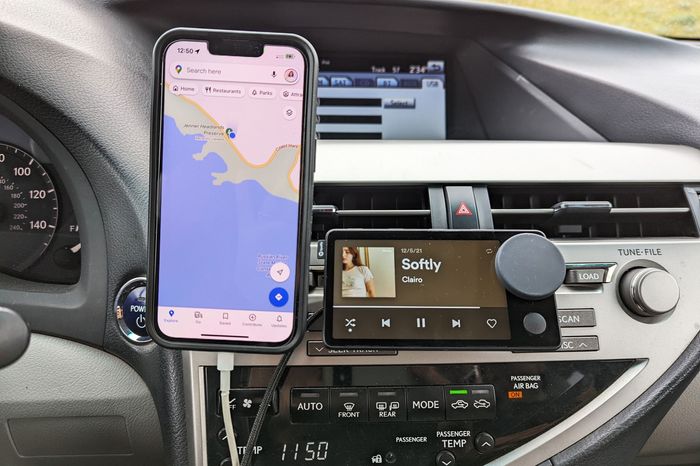I envy CarPlay. My 11-year-old SUV has a multimedia screen, but it lacks Apple’s sleek in-car software. I had no idea what I was missing until I rented a car with the Apple CarPlay/Google Android Auto combo on a recent trip.
No cumbersome menus or buttons: I just plug my phone in and my Google Maps route automatically fills the car’s screen. When texts came in, Siri read them aloud, and at a red light, I quickly found the podcast I wanted to listen to. I was hooked.
share your opinion
How to make your old car smarter? Join the conversation below.
CarPlay, a piece of software that simplifies the often-problematic automotive infotainment experience, started appearing in vehicles around 2014 and Android Auto around four years later. They activate as soon as you connect your phone, and the apps’ large, friendly buttons and voice features are easy to use while you’re driving, and safer than fiddling with your phone. They’re essentially simplified versions of your phone, right on your dashboard.
Unfortunately for me, now is a terrible time to buy a new car. Pandemic-related supply shortages have sent prices for new and used cars skyrocketing, with buyers often waiting months for deliveries. So I started looking to install a CarPlay/Android Auto unit on a vehicle I already own.
If you’re also interested in smartphone systems for existing cars, buckle up: this column is for you.
System-wide upgrade
Many aftermarket multimedia receivers are compatible with CarPlay and Android Auto. They range in price from $200 to $2,000, depending on screen size and other features, and come from brands like Pioneer, Boss, and Kenwood. Some models can connect wirelessly to your phone or include an extra USB charging port, which adds to the cost.

Aftermarket receivers, like this $750 DMH-W4660NEX unit from Pioneer, add CarPlay or Android Auto to an existing car, but require wiring knowledge or professional installation.
Photo: Pioneer
When shopping for these devices, you’ll come across a common term, DIN, which stands for Deutsches Institut für Normung, a German organization that establishes car radio dimensions. A single DIN stereo enclosure is approximately 7 inches wide and 2 inches high, while a double DIN is approximately 7 inches wide and 4 inches high. Auto parts retailer Crutchfield has an online Fit My Car tool that can tell you which DIN is compatible with your model.
I was excited about the prospect of an upgrade – until I learned that my Lexus 450h couldn’t be upgraded.
According to Crutchfield’s head of sales, Brandon Bevins, most car stereos can be replaced for the aftermarket. But there are a few exceptions. “In your Lexus, the factory dash around the radio is not a standard size or shape,” he explained. I need to make a custom kit and the complex installation will cost far more than the standard $125 fee for most vehicles. I called a few auto shops and they quoted me about $1,800 for a special aftermarket receiver, plus at least $350 to install, with the caveat that the total price could be higher. Shh.
Workaround: Intellidash+
Search Amazon for “CarPlay” or “Android Auto” and you’ll find dozens of installable smart screens. Intellidash+ ($350) is an option. It has a 7-inch display with CarPlay and Android Auto capabilities. I was amazed: it worked. The same CarPlay interface that appeared in the rental now works in my car, no professional installation required.
Intellidash+ is not an elegant solution. You’ll need a lot of cables to make it work, including one that connects to the 12V cigarette lighter socket, and another that connects the phone to the screen’s USB-C port. If your car has a 3.5mm jack, there’s also an auxiliary cable for audio. The kit comes with some cable clips to manage the mess.

The $350 Intellidash+ attaches to a car’s dash or windshield via suction cups, adding CarPlay or Android Auto without the need for a dedicated installation.
Photo: Nicole Nguyen/Wall Street Journal
My car doesn’t have a 3.5mm headphone jack, so I connected my iPhone via bluetooth to play audio to the car’s speakers. You don’t want to play music through the Intellidash+’s monstrous, tiny built-in speakers.
The Pixel 6 launches Android Auto without a hitch, but despite several attempts, the Android device’s audio fails to broadcast over Bluetooth. Instead, I used the Intellidash+’s built-in FM transmitter, which sounded fine on my car speakers, but took longer to set up to find the right station.
The telescopic arms of the screen are attached to the dashboard or windshield via suction cups. For the textured dash, there’s an adhesive-backed glass tray in the box that allows the cups to suck up. NOTE: You only have one chance to set up with the adhesive.
Check your local laws before installing anything on your windshield. In California, the device may only be installed in the lower corner of the driver’s side windshield and must not exceed 7 inches square.
Intellidash+ isn’t perfect or as good as the built-in system, but it’s better than many alternatives. I’ve tried other installable CarPlay products, but they’re more clunky. If you don’t want to install an aftermarket unit, the Intellidash+ is a great solution that doesn’t require a full car stereo swap – as long as you’re okay with the cables.
a good mount, maybe a car thing
No matter which system you choose, a sturdy phone mount will make a difference. In my experience, brackets that clip on to the car’s heating/cooling vents are the most reliable. Accessories that stick to the dashboard block your view and are prone to sucker failure or needing to be permanently attached with adhesive, a big downside of the Intellidash+.
For MagSafe-compatible iPhones, Otterbox’s stand ($40) securely holds the phone with a simple snap-on magnetic pad and can be adjusted for portrait or landscape orientation. For others, Belkin’s Premium Auto Vent Mount ($30) has extendable arms and a cable holder at the rear, which can also be viewed in both directions.

Car Thing adds an easy-to-drive Spotify interface to your car, but it’s only available for premium subscribers.
Photo: Nicole Nguyen/Wall Street Journal
Ultimately, my favorite setup doesn’t involve CarPlay at all. It includes my phone, running Google Maps, mounted on my vent, plus a weird $90 gadget, Spotify SPOT -2.14% called Car Thing. (Yes, that’s the real name.)
The small, lightweight screen displays a driver-friendly version of Spotify’s interface and can be mounted to your dashboard, CD player or air vent. It requires a Spotify Premium subscription, and a smartphone with the Spotify app installed and connected to the display via Bluetooth. Then you need to get the audio from the phone to the car via whatever method you normally use. “Why not just your phone?” is a valid question for this product, which is essentially a dedicated Spotify remote.
While it would be nice to have a fully functional CarPlay system, I realize that my most used driving apps are maps and music, and with Car Thing I don’t have to switch between the two. The gadget’s best feature is the set of four buttons at the top, which can be programmed to a specific playlist or podcast, like a shortcut to your favorite radio station. The Car Thing only does one thing—plays audio from Spotify—but it does it well. Finally, add my phone and that’s all I need.
For more WSJ tech analysis, commentary, advice, and top stories, Subscribe to our weekly newsletter.
Write to Nicole Nguyen at nicole.nguyen@wsj.com
Copyright © 2022 The Dow Jones Company. all rights reserved. 87990cbe856818d5eddac44c7b1cdeb8










